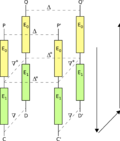Block cipher
In cryptography, a block cipher is a symmetric key cipher which operates on a groups of bits of fixed length, called blocks, using an exact transformation. During encryption, a block cipher algorithm might take (for example) a 128-bit block of plaintext as input, and output a corresponding 128-bit block of ciphertext. The exact transformation is controlled using a second input — the secret key. Decryption is similar: the decryption algorithm takes, in this example, a 128-bit block of ciphertext together with the secret key, and output the original 128-bit block of plaintext.
One of the early block cipher designs was the Data Encryption Standard (DES), developed at IBM and published as a standard in 1977. A successor to DES, the Advanced Encryption Standard (AES); also using block cipher, was adopted in 2001. RC5 is a simple symmetric-key made by Ronald Rivest in 1994.[1] RC6 is another made from RC5. RC stands for "Rivest Cipher", or alternatively, "Ron's Code".
Block Cipher Media
Many block ciphers, such as DES and Blowfish utilize structures known as Feistel ciphers
The Lai–Massey scheme. The archetypical cipher utilizing it is IDEA.
Insecure encryption of an image (depicting Tux) as a result of electronic codebook (ECB) mode encoding
The development of the boomerang attack enabled differential cryptanalysis techniques to be applied to many ciphers that had previously been deemed secure against differential attacks
References
- ↑ Rivest, R. L. (1994). "The RC5 Encryption Algorithm". : 86–96.





